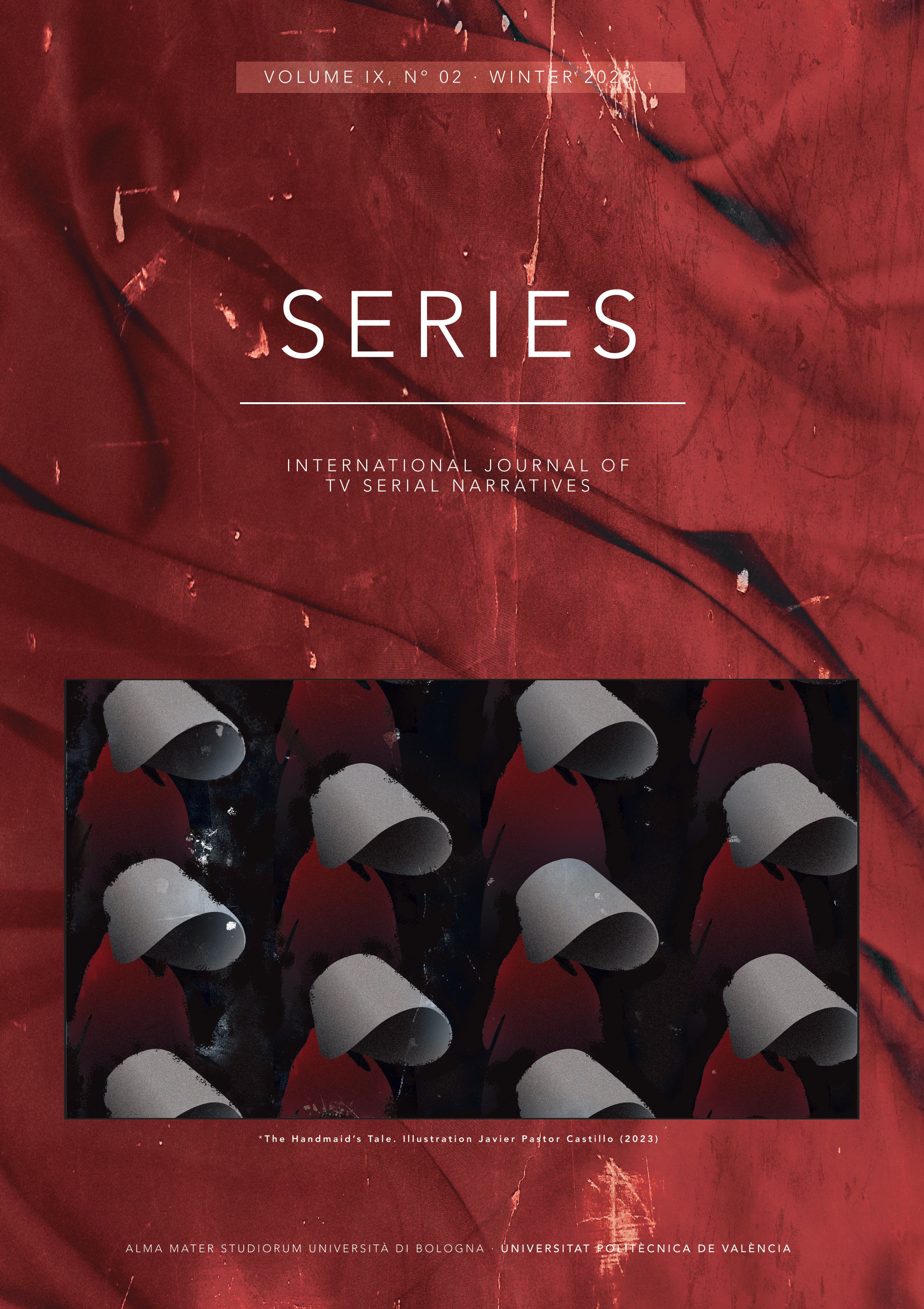The Symbolism and Aesthetics of the Window as a Visual Motif in the TV Series “The Handmaid’s Tale”
DOI:
https://doi.org/10.6092/issn.2421-454X/19492Keywords:
Window, The Handmaid’s Tale, Symbolism, Aesthetics, StagingAbstract
Despite the fact that the TV series "The Handmaid’s Tale" has been widely researched, most studies have addressed aspects like narrative, feminism, violence against women or visual and compositional elements, such as the use of light and the symbolism of colour. However, there is still a dearth of scholarly works focusing on the analysis of the series’ staging and art direction. Accordingly, a comprehensive enquiry is performed here into one such aspect, namely, the windows appearing in the first season of the series. The aim is to verify the aesthetic and staging resources used when windows appear on screen. Additionally, the intention is to determine the kind of windows that stand out because of their symbolism and which are also in keeping with the core concept of the first season of the series. A specially designed analytical tool is employed to examine three of the most relevant windows – those of June/Offred’s bedroom, Commander Fred’s study and Serena’s bedroom – arriving at the conclusion that they are interwoven in both the plot and the characters at a narrative and symbolic level.
References
Amina, Sail (2023). “From Text to Screen: Adaptation and/or Appropriation of Margaret Atwood’s The Handmaid’s Tale into The Hulu Series.” Langues, Médias & Sociétés 10 (1): 519–533. https://aleph.edinum.org/7135.
Atwood, Margaret (2017). El cuento de la criada. Barcelona: Salamandra.
Balló, Jordi (2000). Imágenes del silencio. Los motivos visuales en el cine. Barcelona: Anagrama.
Balló, Jordi and Xavier Pérez (2018). “Los motivos visuales en las series de televisión.” In La estética televisiva en las series contemporáneas, edited by Miguel A. Huerta and Pedro Sangro, 15–35. Valencia: Tirant Humanidades.
Bastidas Mayorga, Paola Anabel (2022). “Estetización de la violencia de género: Análisis visual de la primera temporada de El cuento de la criada.” Ñawi: Arte Diseño Comunicación 6(1): 59–76. https://doi.org/10.37785/nw.v6n1.a3.
Baudelaire, Charles (1970). Paris Spleen. New York: New Directions Publishing Corporation.
Becce, Nicoangelo (2020). “Where Does the Gileadverse Go?: Adaptation and Transmediality in Margaret Atwood’s The Handmaid’s Tale.” Transmedia Storytelling / Narrazioni Transmediali 16: 111–129. https://doi.org/10.13136/2281-4582/2020.i16.916.
Bejarano Petersen, Camila (2021). “Montaje / remontaje de la luz: De la distopía en El cuento de la criada.” Arkadin 10: 1–10. https://doi.org/10.24215/2525085Xe027.
Boyle, Amy (2023). “Domestic Feminism: The Politics of Reproduction and Motherhood in Hulu’s The Handmaid’s Tale.” Television & New Media 25(2): 133-149. https://doi.org/10.1177/15274764231180312.
Cortés-Silva, Laura and Susana Martínez-Guillem (2021). “Blessed be the fight: Misogyny and anti-feminism in The Handmaid's Tale.” In Hate Speech and Polarization in Participatory Society, edited by Marta Pérez-Escolar and José Manuel Noguera-Vivo, 83–97. London: Routledge. https://doi.org/10.4324/9781003109891-8.
Cirlot, Julio Eduardo (2022). Diccionario de símbolos. Madrid: Siruela.
Eco, Umberto (1989). La estructura ausente. Introducción a la semiótica. Barcelona: Lumen.
Fernández, Ricardo (2007). “La ventana indiscreta.” Bulletin Hispanique 109(1): 187–204. https://doi.org/10.4000/bulletinhispanique.143.
Gerrits, Jeroen (2022). “From Episodic Novel to Serial TV: The Handmaid’s Tale, Adaptation and Politics.” Open Philosophy 5: 209–230. https://doi.org/10.1515/opphil-2020-0180.
Grant, Sally (2021). “The ultimate symbol for our times.” BBC Culture, June 28, 2021. https://www.bbc.com/culture/article/20210624-the-ultimate-symbol-for-our-times (last accessed 17-01-24).
Gruber, Monica V. F. (2023). “Heroínas y villanas. Luces y sombras de la República de Gilead.” Cuadernos del Centro de Estudios de Diseño y Comunicación 202: 211–231. https://dspace.palermo.edu/ojs/index.php/cdc/article/download/9832/16600.
Hurley-Powell, Meghan (2020). “Vision and Revision. Transmedia Representations of Agency in The Handmaid’s Tale Novel, Graphic Novel, and Television Series.” Iperstoria. Journal of American and English Studies 16: 91–110. https://doi.org/10.13136/2281-4582/2020.i16.915.
Kaplan, Andrew (2002). “Windows: a meditation on modernity.” Word & Image: A Journal of Verbal/Visual Enquiry 18(3): 162–172. https://doi.org/10.1080/02666286.2002.10404987.
Kim, Ju Oak (2022). “Intersectionality in quality feminist television: rethinking women’s solidarity in The Handmaid’s Tale and Big Little Lies.” Feminist Media Studies 22(6): 1463–1477. https://doi.org/10.1080/14680777.2021.1891447.
Martínez-García, Ángeles (2020). “The Handmaid's Tale (2017) or Hulu’s major investment in great storytelling.” In Handbook of research on transmedia storytelling, audience engagement, and business strategies, edited by Víctor Hernández-Santaolalla and Mónica Barrientos-Bueno, 43–55. Hershey: IGI Global.
Martínez-García, Ángeles and Mar Rubio Hernández (2020). “Mitos subversivos en las series Alias Grace y El cuento de la criada.” Opción, Revista de Antropología, Ciencias de la Comunicación y la Información, Filosofía, Lingüística y Semiótica, Problemas del Desarrollo, la Ciencia y la Tecnología, 92: 59-87. https://hdl.handle.net/11441/101787.
Moldovan, Raluca (2020). “The Dystopian Transformation of Urban Space in Margaret Atwood’s The Handmaid’s Tale.” American, British and Canadian Studies Journal 34: 103–123. https://doi.org/10.2478/abcsj-2020-0007.
Panofsky, Erwin (1987). El significado de las artes visuales. Madrid: Alianza Forma.
Pérez Cifuentes, Herminia (2008). “La simbología de la ventana en la Literatura y en el Arte.” Revista Diotima de Mantinea: 1698–2622. http://www.realidadyficcion.es/Revista_diotima/Herminia/ventanas.htm#:~:text=La%20ventana%20es%20s%C3%ADmbolo%20de,sea%20para%20recordar%20el%20pasado (last accessed 22-12-23).
Roche, David (2021). “Shallow Focus Composition and the Poetics of Blur in The Handmaid’s Tale (Hulu, 2017–).” In Adapting Margaret Atwood, edited by Shannon Wells-Lassagne and Fiona McMahon, 127–141. London: Palgrave Macmillan.
Robinson, Andrea (2019). The Art and Making of The Handmaid's Tale. London: Titan Books.
Tesone, Pablo (2023). “Diseño de diferencias. El caso de El cuento de la criada.” Arte e Investigación 23: 1–12. http://papelcosido.fba.unlp.edu.ar/ojs/index.php/aei.
Wells-Lassagne, Shannon and Fiona McMahon (2021). Adapting Margaret Atwood. London: Palgrave Macmillan.
Yuan, Jada (2017). “How Reed Morano Created the Emmy-Winning Look for The Handmaid’s Tale.” Vulture, September 21, 2017. https://www.vulture.com/2017/09/the-handmaids-tale-how-reed-morano-created-its-look.html (last accessed 17-12-23).
Downloads
Published
How to Cite
Issue
Section
License
Copyright (c) 2023 Ángeles Martínez-García, Mónica Barrientos-Bueno

This work is licensed under a Creative Commons Attribution 4.0 International License.




